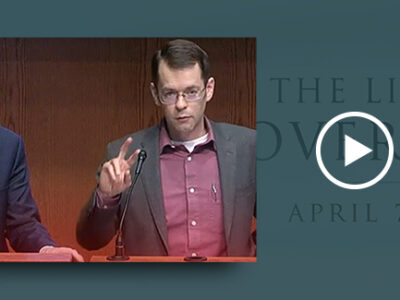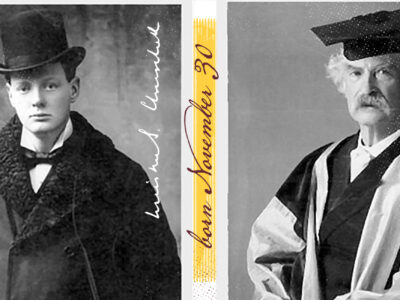
Richard M. Weaver (1910-1963) was one of many conservative intellectuals who took on the task of expressing a conservative political philosophy in the wake of the Second World War and the resulting advent of the Cold War. They all sought to restate conservatism in light of the rise of a powerful, centralized state. Some conservatives made their peace with the new political economy. Weaver was among those who did not do so, but instead sought to express a conservative worldview in terms of fundamental principles.
 The first principle Weaver advanced was that the world is a creation of a Creator. In October 1960, he delivered a lecture to a group of seminarians at Holy Name College, “Conservatism and Liberalism” (reprinted in his book, In Defense of Tradition), in which he contrasts their worldviews.
The first principle Weaver advanced was that the world is a creation of a Creator. In October 1960, he delivered a lecture to a group of seminarians at Holy Name College, “Conservatism and Liberalism” (reprinted in his book, In Defense of Tradition), in which he contrasts their worldviews.
On the worldview of conservatives, he wrote:
To begin with, and most importantly, the conservative believes in the existence of a non-self. This is but a way of saying that he believes in creation. He does not believe that the world began with him or will end with him. There is a creation, older than himself, greater than himself, which has ontological status. His position is really one of modesty. Perhaps the surest mark of the conservative is this willingness to respect or venerate something other than himself. He believes in the uniqueness of man, but he does not translate this uniqueness as supremacy or omnipotence. He sees rather that this unique creation is limited and is subject to restraints.
On the worldview of liberals, Weaver wrote:
Now when we turn to the modern liberal, we find a person who increasingly places man at the center of things—indeed, not only at the center, but in potentially unlimited control. This liberal does not concern himself much with whether this world is a creation. Generally, he seems to think it isn’t, and in any case he appears indifferent toward finding out whether the creator had designs. The world appears to him a brute, empirical fact, which man has got to subdue and manage….To conclude, the modern liberal has tended to embrace a cosmological view which deifies man. The wishes of man are the last court of appeal and nothing that he wants to do can really be repudiated.
The second principle that Weaver emphasized, and which aligned his position on the political spectrum differently from those of others in this group of conservative thinkers, was what he called the structure of reality.
In May 1960, Richard Weaver published an essay “Conservatism and Libertarianism: The Common Ground” (reprinted in his book, In Defense of Tradition). He gave the following “essential definition” of a conservative:
It is my contention that a conservative is a realist, who believes that there is a structure of reality independent of his own will and desire. He believes that there is a creation which was here before him, which exists now not by just his sufferance, and which will be here after he’s gone. This structure consists not merely of the great physical world but also of many laws, principles, and regulations which control human behavior. Though this reality is independent of the individual, it is not hostile to him. It is in fact amenable by him in many ways, but it cannot be changed radically and arbitrarily. This is the cardinal point. The conservative holds that man in this world cannot make his will his law without any regard to limits and to the fixed nature of things.
For Weaver, the conservative is “standing on terra firma of antecedent reality; having accepted some things as given, lasting and good.” “The conservative,” Weaver wrote, “wants to conserve the great structure of reality which has been given to us and which is on the whole beneficent.”
The application Weaver makes of these great truths is summed up in the dictum of Francis Bacon who declared that “man learns to command nature by obeying her.” To flourish, human society must likewise conform to the laws of human nature. Weaver wrote:
The same holds for the moral, social and political worlds. One does not command these by simply trying to kick them over. One commands them as far as it is possible to do so or appropriate to do so by obeying them—by taking due note of their laws and regulations and by following these and then proceeding to further ends.
In contrast to the conservative, the radical “makes his will the law.” His attitude toward the structure of reality is “contemptuous” because “nothing can be superior to man.” He has, therefore, “indifference or hostility toward religion,” and “impatience with existing human institutions.” Impediments in the way of what he wants are “regarded as either accidents or affronts.” The radical eschews the “normal process of logical demonstration, appeal and moral suasion,” and adopts “the use of force or constraint” to impose his will. “His first thought now,” Weaver wrote, “is to get control of the state to make all men equal or to make all men rich, or failing that to make all men equally unhappy.” It is in his “use of the political instrumentality to coerce people to conform with his dream, in the face of their belief in a real order,” that conservatives oppose the radical.
In doing so, Weaver thought conservatives could join with libertarians on the common ground of the structure of reality. He wrote:
Both of them believe that there is an order of things which will largely take care of itself if you leave it alone. There are operating laws in nature and in human nature which are best not interfered with or not interfered with very much. If you try to change of suspend them by government fiat, the cost is greater than the return, the disorganization is expensive, the ensuing frustration painful. These laws are part of what I earlier referred to as the structure of reality. Just as there are certain conditions of efficiency for the operation of the physical world, so there are conditions for efficient operation in the social and economic world.
 In referring to the “conditions for efficient operation in the social and economic world,” Weaver was singling out economists who accepted the structure of reality as the foundation of economic analysis. Just as he rejected the conservativism of Edmund Burke because it was grounded on “circumstances and expediency” and not “definitions and principle,” Weaver rejected positivists like Milton Friedman. Instead, Weaver embraced the praxeology of Ludwig von Mises, who coined the term in his treatise Human Action. “There is a concept expressed by some economists today in the word ‘praxeology,’” Weaver wrote. He realized that among the various approaches to economics, praxeology accepted the structure of reality and built upon that foundation. “Praxeology, briefly defined,” Weaver wrote, “is the science of how things work because of their essential natures.”
In referring to the “conditions for efficient operation in the social and economic world,” Weaver was singling out economists who accepted the structure of reality as the foundation of economic analysis. Just as he rejected the conservativism of Edmund Burke because it was grounded on “circumstances and expediency” and not “definitions and principle,” Weaver rejected positivists like Milton Friedman. Instead, Weaver embraced the praxeology of Ludwig von Mises, who coined the term in his treatise Human Action. “There is a concept expressed by some economists today in the word ‘praxeology,’” Weaver wrote. He realized that among the various approaches to economics, praxeology accepted the structure of reality and built upon that foundation. “Praxeology, briefly defined,” Weaver wrote, “is the science of how things work because of their essential natures.”
Conservatives and libertarians, according to Weaver, build on the same foundation. He wrote:
The conservative and the libertarian agree that it is not only presumption, it is folly to try to interfere with the workings of a praxeology. One makes use of it, yes, in the same way that a follower of Bacon makes use of nature by obeying her. The great difference is that one is recognizing the objective; one is recognizing the laws that regulate man’s affairs. Since the conservative and libertarian believe that these cannot be wished away through the establishment of a Utopia, they are both conservators of the real world.
Because they reject the structure of reality, Weaver recognized that conservatives and libertarians have a common enemy in “the radicals and militant liberals.” He wrote:
Not only do they propose through their reforms to reconstruct and regiment us, they also propose to keep us from hearing the other side. Anyone who has contended with Marxists and their fist cousins, the totalitarian liberals, knows that they have no intention of giving the conservative alternative a chance to compete with their doctrines for popular acceptance.
The conservative, in contrast, is tolerant “because he has in a sense squared himself with the ‘structure of reality.” “He does not have to be nervously defensive about it,” stated Weaver, because “a new idea or an opposing idea is not going to topple his.” Therefore, “he doesn’t feel that terrible need to exterminate the enemy which seems to inflame so many radicals of both the past and the present.”
Weaver concludes about the radical:
As an individual he may think about molding the world to his heart’s desire. He may even publish the results of his thinking. But when he tries to use the instrumentality of the state to bring about his wishes then all of us are involved, and we have to take our stand.
Now more than ever, conservatives and libertarians who share a foundation in the structure of reality must stand together in defense of the created order.




